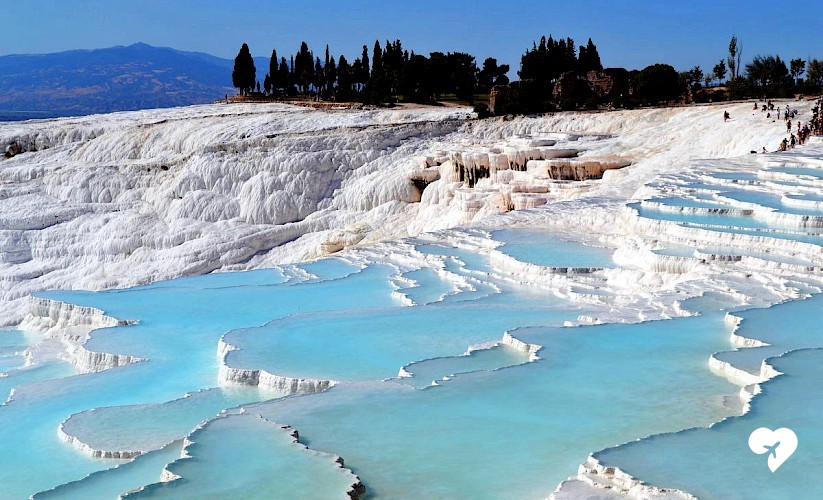A Marvel of Nature and a Roman City side by side
Pamukkale appears in almost every list of places to be seen before you die and visited by almost two million tourists each year. Pamukkale is a place where nature assumed the role of artist and created such majestic beauty. The white travertine cascades resembling frozen waterfalls and terraces of shallow pools were created by the waters of thermal springs reacting with the air. Its allure first noticed by the Romans. The magnificent Hierapolis ancient city was established near the travertine by the Romans. Those unique travertine and the ancient ruins were inscribed in the UNESCO World Heritage List.
2.000 Year Old Centre of Beauty and Health
Pamukkale would enchant visitors at the first sight. Under the spell of travertine Pergamon Kingdom established the Hierapolis city nearby 2.000 years ago. At that era Hierapolis served as a thermal health center and visitors from various parts of Anatolia flocked to the city to receive a balneal treatment in search of health or beauty. In our age, those who seek beauty or health still dip in the thermal pools. You may also enjoy swimming the timeless pools as your ancestors did, and enjoy the majestic sight of the travertine. However, the natural beauty created over thousands of years is so fragile. Therefore only certain areas are open to paddling or dipping. Those who seek a cure should arrange a longer stay at Pamukkale to enjoy balneal treatment, mud baths, and massages in thermal spa resorts around the city of antiquity and travertine city.
Legendary Temples
The Hierapolis city of antiquity has reached our times in a quite well preserved state. The most frequented structure of the antiquity should have been the Roman Baht House, and at present the same building is used as the archeological museum. Many artifacts were unearthed during the excavations carried out in Hierapolis and other nearby sites of antiquity, and some of the statues and other items are on display in the museum. The ancient theater, temples, monumental fountains, necropolis, agora, and gymnasium are quite well preserved to make you feel travelling 2.000 years back in time. You would find the story of Pluto's Gate (Plutonium) which was believed to be the Gate of Hell during the Roman Era, very fascinating.
.jpg)
St. Philip Martyrium and Gravesite
In Christianity Hierapolis is a holy settlement. The holiness is attributed to the fact that St. Philip, one of the Twelve Apostles of Jesus Christ, was martyred in the city. The Martyrium was built by the palace architects in 5th century, and it is a holy pilgrimage site for Christians. The ruins of Cathedral dating back to 6th century contain the baptistery as well as metropolitan bishop's chapel. The 7th century church is renowned as the Church of Columns (Direkli Kilise) is the other important structure from Christian era. There are several other chapels scattered around the town. Those structures prove that Hieropolis was an important religious centre during the Eastern Roman Empire era. That is the reason why the archaeologists named it as the holy city.
Unique Sunset
Pamukkale provides several unique experiences to its visitors. Enjoying the magnificent sight created by the sunset colouring the travertine in beautiful hues, is an experience worth to extend your visit.
How to Go?
The travertine is situated in Pamukkale County, to the north of Denizli city. There are rail connections to Ankara, Istanbul, and Izmir, and coaches provide connections to major cities. There are minibus services to Pamukkale from the coach terminus at Denizli city centre. The Cardak Airport has twice daily flights to and from Istanbul.
